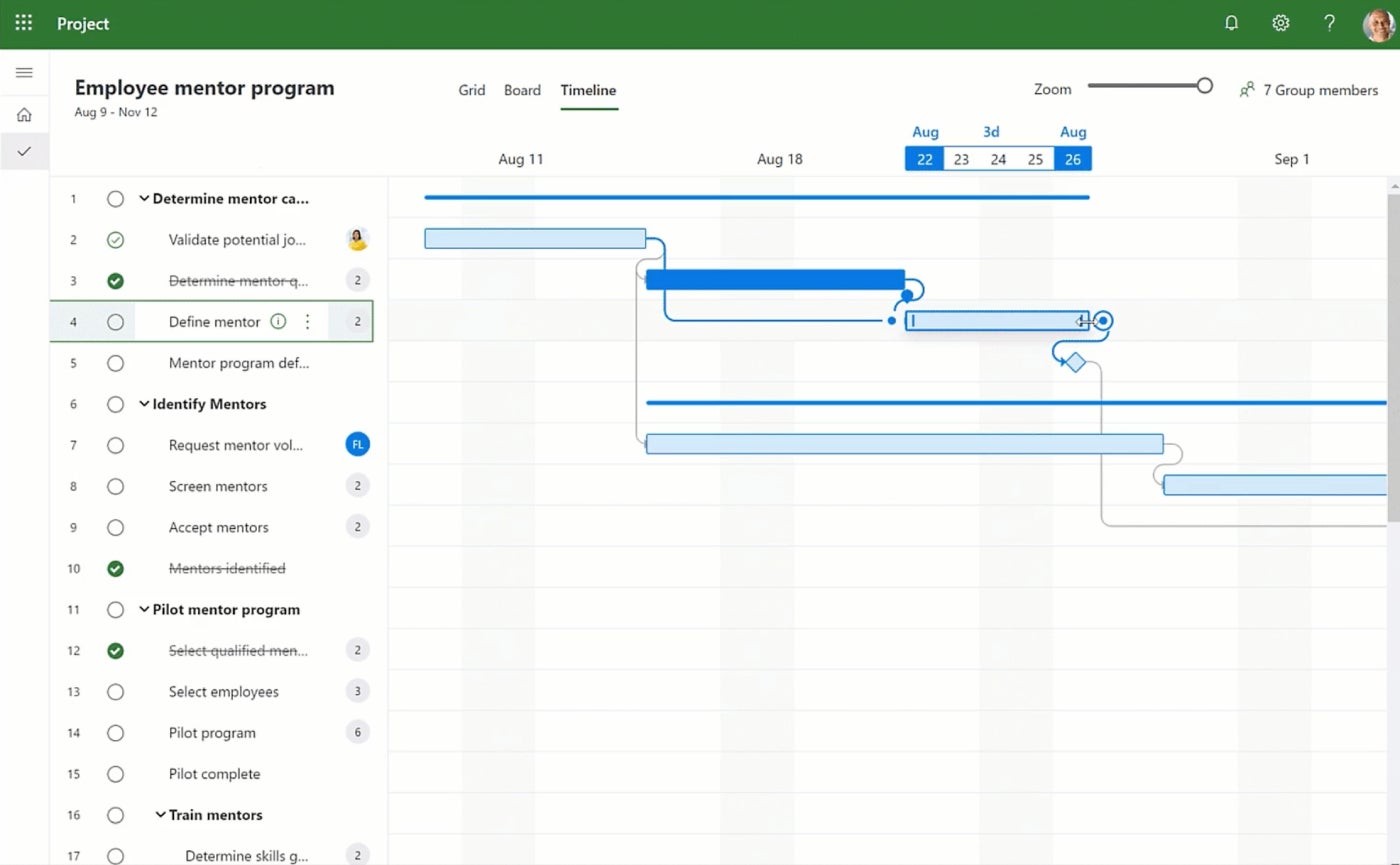
Microsoft Project and Smartsheet are two popular project management software platforms that have a more traditional user interface design. While they may seem similar at first glance, once I started reviewing both software, the differences became apparent:
| Document management | ||
| Communication tools | ||
| Time tracking | ||
| Reporting | ||
| On-premises deployment | ||
| Pricing | ||
|
|
Microsoft offers far more pricing plans to choose from than Smartsheet, as well as on-premises options. However, Smartsheet is more affordable than Microsoft Project overall. Both software offer a 30-day free trial for certain plans.
Cloud-based subscriptions:
On-premises solutions:
For more information, read the full Microsoft Project review and view our list of Microsoft Project alternatives.
For more information, read the full Smartsheet review and view our list of Smartsheet alternatives.
Winner: Smartsheet
Microsoft Project ranked 3.9/5 for features overall on our scoring rubric. It offers three main project views: grid, board and timeline (Gantt) view. The design is similar to other Microsoft products, but I didn’t find the interface particularly intuitive to use, and the sheer number of features can be overwhelming and make it difficult to find what you need. The tool gives you the option to get very detailed with resource management, such as tracking costs of materials over the course of a project or seeing how much time an individual has spent on a task.
Smartsheet ranked somewhat better, scoring 4.6/5 for features overall. It offers four project views: grid, card (kanban), calendar and Gantt. It’s not the most colorful or appealing interface, but it is easier to navigate than Microsoft Project, in my opinion. You can either start with a blank sheet or use a template to help guide the process. Conditional formatting rules speed up the process even further, and you can also create automation rules to cut down on manual work. Smartsheet does offer a paid add-on for resource management, but it’s not as robust as Microsoft Project.

Winner: Tie
You can upload documents to a site in Microsoft Project, but editing and updating capabilities are limited because the assumption is that you are already using SharePoint or OneDrive for document storage and management. Microsoft Project also doesn’t really integrate with other apps, so you can’t use an outside platform like Google Docs either. This is one of the reasons why Microsoft Project is best used by teams that are already committed to the Microsoft ecosystem.
Smartsheet also allows you to upload files to a project, and it links to multiple popular document management solutions, including Google Drive, Dropbox and OneDrive. The Business and Enterprise plans also offer a proofing feature that allows teams to visually mark up content, including videos, within the Smartsheet tool to keep everything centralized in one place. If you’re not already using SharePoint or OneDrive, then I would recommend Smartsheet as the better choice for document management.

Winner: Tie
Similar to document management, Microsoft Project does not contain any native features for communication or collaboration. Instead, users will be prompted to connect with colleagues using one of Microsoft’s many other communication tools, including Teams, Outlook and Skype. If you aren’t already part of the Microsoft ecosystem, then you will need to invest in other software that can take over this function — and it won’t integrate with Microsoft Project.
On the other hand, Smartsheet allows teams to have conversations via comments on sheets and rows: Individuals can tag each other in comments to send a notification. Comments can also be accessed via the mobile app so you can read and respond on the go. While it doesn’t offer a more robust native chat function, it does integrate with some messaging platforms, such as Slack, to supplement the built-in comment feature.

Winner: Smartsheet
Smartsheet ranked significantly better than Microsoft Project when it comes to ease of use. Smartsheet rated 3.5/5, while Microsoft only got 1.8/5, which is really low! Smartsheet isn’t the most intuitive project management software I’ve tested, but it was far easier to figure things out compared to Microsoft Project since the layout is more logical. It was also much faster to create and load new projects in Smartsheet, and the larger number of template options helped speed up that process further.

Winner: Microsoft Project
On the other hand, Microsoft Project scored a bit better than Smartsheet on the customer service front: Microsoft Project got 4.2/5 and Smartsheet got 3.8/5. The reason for this is that Smartsheet paywalls certain support features (such as 24/7 phone support and a chat bot app) either to the more expensive plans or to a paid support add-on that costs an additional fee. Microsoft Project doesn’t charge extra for support, though some users do say that the customer service could be improved.
Winner: Smartsheet
When it comes to integrations, Smartsheet beats Microsoft Project by a landslide. Not only does Smartsheet offer 100+ native integrations, it also connects to thousands of more platforms through Zapier. In contrast, Microsoft Project’s native integrations are mostly limited to other Microsoft products, and it doesn’t connect to Zapier (unlike some other Microsoft products), so there isn’t even a workaround.
If neither Microsoft Project nor Smartsheet sounds right for you, don’t worry. There are plenty of other project management solutions out there, including some with forever free plans. Check out our picks for the top project management software of 2024 to see what your options are.
To compare these project management tools, I signed up for free trials in addition to viewing demo videos, consulting project documentation and reading user reviews. I considered features such as task management, portfolio management, document management and communication tools. I also weighed other factors such as ease of use, customer support, integrations and pricing.